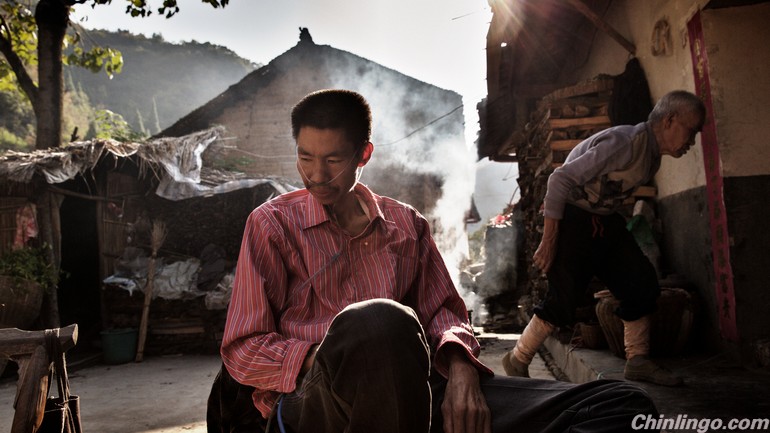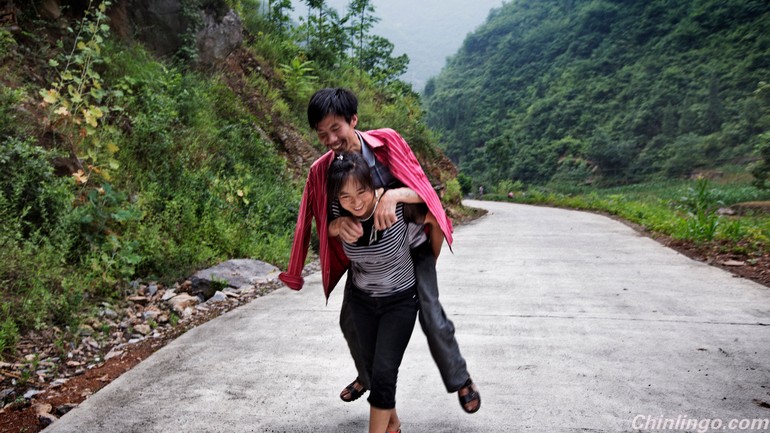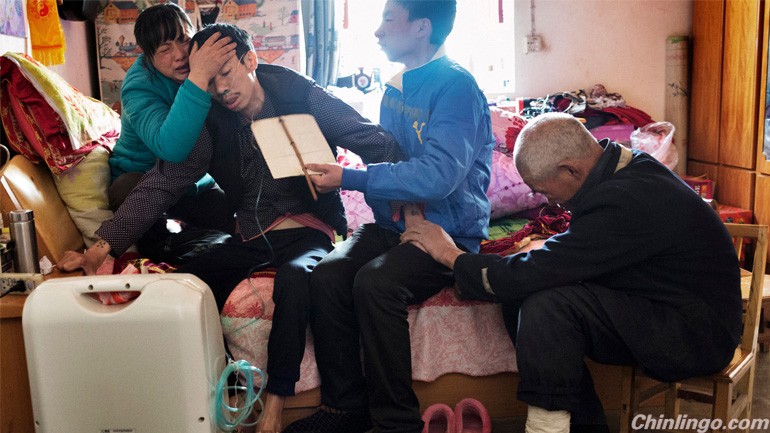
He Quangui spends his days in a bed connected to a battered oxygen machine that pumps air into his lungs. The monotonous sound is punctuated only by his gasping cough. Like many of his fellow villagers in a mountainous area of Shaanxi Province in China, he answered the government's call to leave his farm and make a better living as a migrant worker in the 1990s.
何全贵成天躺在床上,身体连接着一个把空气输送到他肺里的破旧的氧气机。机器发出单调的声响,时不时穿插着他喘不上气来的咳嗽声。上世纪90年代,和很多居住在陕西山区里的老乡一样,他响应政府号召放弃务农,为谋得更好的生计而外出打工。
He went to work in an illegal gold mine, which, while helping fuel China's growing economy, cost him dearly: He has silicosis, a form of pneumoconiosis, China's most common occupational disease.
他去了一家非法金矿工作。这样的金矿为中国的经济增长提供了动力,同时也让他付出了沉重的代价。何全贵患上了矽肺病。这是中国最普遍的职业病尘肺病的一种。
Today, when he leaves his bed, he often collapses, unable to breathe. There are treatments that could prolong his life and ease the suffering, but he has neither money nor benefits after his seven years working in the mines.
如今,只要他一下床,就经常会瘫软在地,无法呼吸。通过治疗可以延长他的生命,缓解痛楚。可是,尽管他在矿场工作了七年时间,他既没钱,也不享有福利。
Had he not met the photographer Sim Chi Yin at his fruit stand in 2011, he would most likely be dead. She came to his remote village to document the ravages of lung disease among the men who worked as migrant miners. To make the story more immediate, she sought a dying miner to be the main character, and soon settled on Mr. He. Mr. He learned he had silicosis in 2004. He lived in an old earthen house with his wife, Mi Shixiu, and their son, Jinbo. Together, they sold fruit; Ms. Sim stayed in a spare room above the stand, taking photos while trying to persuade the couple to let her into their lives. Though she started out doing a story about silicosis, she soon saw a different narrative.
如果不是2011年他在自家的水果摊遇到了摄影师沈绮颖(Sim Chi Yin),他很可能已经离开了人世。沈绮颖来到他所在的偏远村庄是为了记录肺病对外来矿工的摧残。为了突显问题的紧迫性,需要寻找一个垂死的矿工作为主角,她很快便选定了何全贵。何全贵在2004年得知自己患上了矽肺病。妻子米世秀、儿子何进波和他一起住在一间老旧的土房里,全家人一起贩卖水果。沈绮颖待在水果摊上面的一间空房里,在摄影的同时,她尝试着说服夫妇二人允许自己走进他们的生活。尽管一开始是想要讲述有关矽肺病的故事,但是沈绮颖很快便发现了另一个角度。

"I realized this was not just a story about a dying man in a remote village in China," she said. "It was a universal love story."
"我意识到,这个故事不光是说中国的偏远农村里有一个垂死的人,"沈绮颖说。"这是一个普世的爱情故事。"
"Their love was so powerful and palpable and so pure," she said. "Even now, they cuddle and play like teenagers."
"他们之间的爱是如此的热烈、外露和纯粹。即便是现在,他们仍然会相互依偎,像少年一样打闹,"她说。
Ms. Sim returned home after a week with some photos and a sense that the project might not work out because the couple was not interested in being photographed over a long period. But six months later, Mr. He's wife called, crying and desperate for help.
沈绮颖在拍摄了一周后返回家中。因为夫妇俩对长期跟拍不感兴趣,她感觉到计划可能无法实现。然而,六个月后,何全贵的妻子打来了电话,绝望地哭诉着向沈绮颖求助。
Ms. Sim contacted a friend, an investigative journalist who ran an organization for poor people with silicosis. It arranged for a $1,600 grant so Mr. He could get treatment at a hospital. She flew to Xi'an and picked up Mr. He, who could not walk and had to be carried by his brother-in-law.
沈绮颖联系了一名调查记者。这位朋友开设的一家机构专为患有矽肺病的贫困人士提供帮助。他们为何全贵筹集了1万元人民币,让他能够入院接受治疗。沈绮颖飞去西安接何全贵。他当时无法行走,只能由妹夫背着。

She spent long days at the hospital as both "caretaker and court jester trying to lift his spirits," she said. At night, she returned to her hotel room and sobbed. Depressed, Mr. He asked Ms. Sim to take him far away, kill him and dump his body if the treatment failed.The hospital stay was a turning point. Ms. Sim was no longer a stranger but, according to Mr. He, was his "savior." From that point, she stayed in his home whenever she visited, and she became close to his family. Her intervention changed the story, and Ms. Sim acknowledges that some might find that unethical. But she felt the situation demanded action.
沈绮颖在医院待了很长时间,"既是看护,又要插科打诨来振奋他的精神,"她说。夜里,她会回到酒店房间里啜泣。沮丧的何全贵曾说,如果治疗失败的话,想让沈绮颖带他走,杀了他,再把他的尸体扔掉。这次治疗成为了一个转折点。对于何全贵而言,沈绮颖不再是一个陌生人,而是用他的话来说成了"救命恩人"。从那时起,不论何时到访,沈绮颖都住在何全贵的家中,他们一家人和她的关系也变得亲近了。沈绮颖的介入改变了这个故事,她自己也承认,有些人可能会觉得自己的行为不符合职业道德,但是她认为这是形势所迫。
"I was a human being first and a photographer second," she said. "As a documentary photographer, I want to bring about change around large issues, but given the opportunity to make a concrete change in one person's life, it would be unconscionable not to do so."
"我首先是一个人,然后才是一个摄影师,"她说。"作为一名纪实摄影师,我希望在大事上带来改变,但如果有机会让一个人的生活发生具体的变化,不去做的话就不对了。"
She has spent much of the last four years following Mr. He's travails, living in his home and falling asleep in the next room listening to the drone of the oxygen machine. Once, she was awakened before dawn when Mr. He attempted suicide.
过去四年里,沈绮颖用了大量时间记录何全贵经历的困苦。她住在何家,睡在隔壁屋子里,听着氧气机的嗡嗡声。有一次,当何全贵企图在凌晨自杀时,她被惊醒了。
In her journal, Ms. Sim noted him saying: "I have completely given up hope this time. Moaning out loud, short of breath. If I were a rich man, I'd see it differently. I'd go to a hospital in the city and use the best drugs, and I'll still be able to live for a few more years. But I don't have the money."Ms. Sim, who sometimes photographs for The New York Times, has turned her attention to getting Mr. He's story out while he is still alive. Despite the powerful images, she has had few takers.
沈绮颖在日记里写道,何全贵说:"我这一次彻底不抱希望了。大声哼哼、气短。如果是个有钱人,就不一样了。我会去城里的医院,用最好的药,还能再多活几年。但我没钱。"有时会为《纽约时报》拍摄图片的沈绮颖,此时已经转移了注意力,致力于在何全贵的有生之年,把他的故事刊登出来。尽管这些影像颇能打动人,但却鲜有媒体接收。
"I've showed the photos and video to perhaps 15 or 20 editors, some of whom cried, but no one would publish it in print," she said. "It's not a sexy subject, and the photos aren't highly aestheticized."
"我给大概15或20个编辑看过照片和视频。有些人都看哭了,但没人愿意刊登,"她说。"这不是一个迷人的话题,照片也没有很高的美学价值。"
They are not over-processed, blurry black-and-white images, nor are they fine art portraits, she added.
她接着说,它们不是那种过度加工的朦胧的黑白照片,也不是精美的肖像照。
"This is a story that is not about me or my vision or my aesthetics," she said. "It's about a dying man and the impact on his family. It's about this disease that's China's No. 1 occupational disease, period."
"这个故事和我本人、我的见解或审美无关,"她说。"它讲的是一个垂死的人,以及他的家庭遭受的影响。讲的是中国的头号职业病,就这样。"
National Geographic is the only magazine that expressed serious interest in publishing it, though a 10-page layout was ultimately rejected for publication. Instead, a video on Mr. He was featured on its photo blog, Proof.
《国家地理》(National Geographic)是唯一认真考虑登出这个故事的刊物。但最终,10页篇幅的版面还是没能问世。不过,一段介绍何全贵的视频,放在了杂志网站的图片博客Proof上。
Mr. He now has an inexpensive smartphone and uses social media to share health information with other miners with silicosis. He weighs less than 90 pounds but "is still hanging on," Ms. Sim said. To keep his spirits up, she tells him that he must stay alive to see the impact of the videos and photo essay.
现在,何全贵有一部廉价的智能手机,能通过社交媒体和其他患矽肺病的矿工分享健康讯息。何全贵体重不到90磅(约合41公斤),但沈绮颖说,他"依然在坚持"。为了让他保持良好的精神状态,沈绮颖对他说,他必须活着看到自己的视频和图片产生了什么样的影响。
The Chinese news and photo website Tencent published the photos and videos this month and raised $16,000 from readers for Mr. He, who can now go to a hospital for new treatments, repay some debts and fix his leaking roof.
本月,中文新闻和图片网站腾讯刊发了相关照片和视频,并从读者那里为何全贵筹集到了10万元人民币。现在,何全贵能够去医院重新接受治疗,还一部分债,再修补一下漏雨的屋顶。
Mr. He sent a text to Ms. Sim last week: "I didn't think that I could hold on and live till now, that I would see this happening with my own eyes, that I would enjoy the fruits of this collaboration myself and have it prolong my life."
上周,何全贵给沈绮颖发了一条短信:"没想到我能坚持活到现在,能亲眼看到这一切,能亲身享受这种合作的果实,让它延长我的生命。"



 闽公网安备 35020302035673号
闽公网安备 35020302035673号
0 responses on "The story of a Chinese silicosis sufferer"